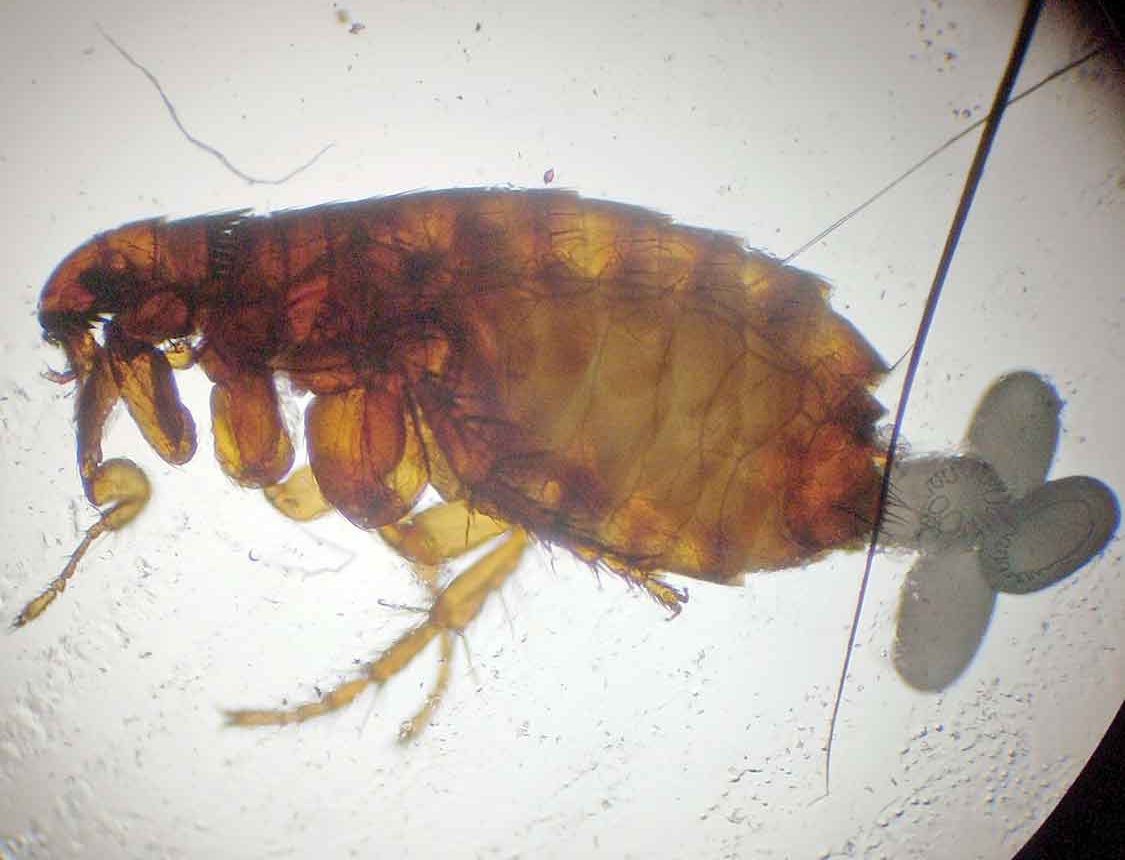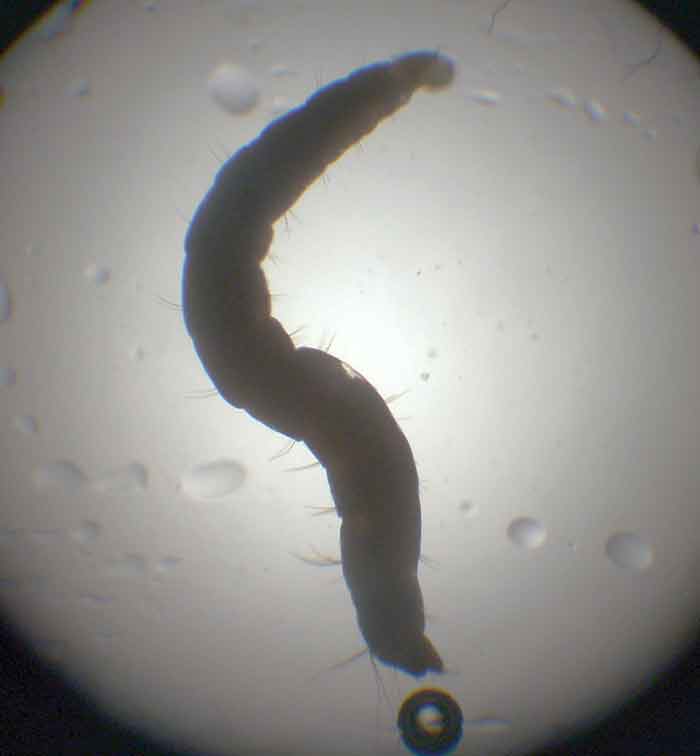4 Mar 2019
Can insecticidal sprays adequately control fleas?
Ian Wright discusses the effectiveness of using sprays to control parasites and how owners can take preventive measures.

Figure 1. Adult cat flea and eggs.
The cat flea (Ctenocephalides felis) is thriving in the UK with mild winters and centrally heated homes. Fleas are a source of revulsion, distress and irritation to pet owners, but can also transmit disease to pets and owners alike. It is vital, therefore, veterinary professionals are able to give accurate advice regarding flea control.
While treating all pets with an effective adulticide on pets to prevent flea egg production remains the most important component of flea control, treatment of the environment is also important to eliminate existing infestations as quickly as possible. Flea sprays are a commonly used method of environmental flea control, but only effective if used correctly and as part of an overall flea control strategy.
Cat fleas are thriving in the UK – with milder and wet weather conditions allowing prolonged survival, and favourable breeding conditions in outdoor environments.
Central heating also allows environmental stages of the flea life cycle to persist all year round in the home. This combination of factors leads to increased flea challenge on domestic pets and, without routine preventive treatment, the risk of flea infestations establishing is high (Coles and Dryden, 2014).
Although the cat flea (Ctenocephalides felis) cannot live and reproduce on humans, it can bite, leading to human irritation.
It is also a source of revulsion – eroding the human-animal bond – and a cause of flea allergic dermatitis, anaemia in heavy infestations and vectors for a variety of infections, including Bartonella henselae (the cause of cat scratch disease), Rickettsia felis (a cause of spotted fever) and haemoplasmas (the cause of feline infectious anaemia).
Flea control is, therefore, vital to reduce disease risk and maintain a strong human-animal bond. Successful flea control strategies require consideration of the flea life cycle and prevention of flea reproduction.
Basis of flea control
The most important aspect of flea control is to ensure adult fleas are killed on the pet before they can initiate egg production. Physical and chemical treatment of the environment is also important to reduce environmental larvae and eggs. For effective flea control to occur, choice of adulticide and how to effectively treat the environment both need to be considered.
Even if an effective adulticide and environmental treatment are used, established infestations will still take at least three months to eliminate (Dryden et al, 2000). This needs to be effectively communicated to clients or they may become disillusioned with the products used and compliance may be reduced.

Use of an effective adulticide
Adult fleas (Figure 1) can lay eggs within 24 hours, so the adulticide chosen must kill fleas at least within that time. They must also be administered frequently enough to continue to prevent flea egg laying. The time after application of the adulticide at which fleas survive long enough to lay eggs is known as the “reproductive break point”. If the reproductive break point is reached then flea control will fail.
Frequent swimming or shampooing may affect the efficacy and duration of action of imidacloprid and fipronil spot-on solutions, so this should be considered when choosing a product. Many flea products are also effective against other parasites, so other parasite control requirements will also influence product choice.
Environmental control
Environmental treatment to reduce viable eggs (Figure 2), larvae (Figure 3) and pupae is also essential in existing infestations as they will decrease the time required to bring an infestation under control. This, in turn, will reduce vector-borne disease transmission, and the number of flea bites pets and owners receive. The aim of environmental treatment is to reduce the number of flea life stages in the home.
Reducing eggs and larvae will, in turn, reduce the number of pupae. When fleas pupate, debris from the environment adheres to the pupae, making it highly resistant to both adverse environmental conditions and insecticide. Ideally, environmental treatment needs to target pupae as effectively as larvae and eggs, persist in the environment, and be safe to pets and people with minimum ecological impact.

No single environmental treatment fulfils all these criteria, however, so effective treatment of the environment requires the combination of a number of strategies, including:
- Physical cleaning – daily vacuuming has been demonstrated to be useful in reducing pupae, eggs and larvae in households (Hink, 2007). Washing bedding at least 60°C will also help reduce environmental stages (Blagburn and Dryden, 2009).
- Environmental pesticides – the use of pyrethroids to treat the infested environment will reduce larval and egg numbers significantly, if exposure to the insecticide is adequate. Pyrethroids are available in combination with growth regulators in flea sprays, or on their own at higher concentrations in “flea bombs” or fogging devices. The adulticide selamectin shed in hair, and flea faeces also has an ovicidal and larvicidal effect.
- Dimeticone sprays – the use of heavy oils in spray form has been produced as an environmentally friendly alternative to insecticides. It also has the advantage of being able to be used if pet invertebrates or fish are in the household. Adult fleas and larvae are immobilised by a surface film of dimeticone by inhibiting movement of cuticular joints. Similarly, adults can be prevented from emerging if pupae are adequately exposed. In one study, an aerosol spray incorporating 0.4% concentration of dimeticone, for use as a residual household treatment, showed no significant difference in knock-down capability compared with a pyrethroid spray in a repeat challenge test (Jones et al, 2014). Residual efficacy, however, has not been demonstrated more than three weeks post-application.
- Growth regulators – this group includes methoprene, S-methoprene and pyriproxyfen. They act by interfering with the hormonal control of growth in immature fleas, preventing development from one larval stage to the next. By keeping flea larvae at an immature stage for a prolonged period of time, larval death occurs. Larval growth regulators are found in combination with pyrethroids in flea sprays or in combination with adulticides in spot-on preparations. In the latter case, they are shed into the environment after application to the pet. Lufenuron prevents egg hatching and can be used as an alternative to adulticide in cats and dogs. It does not kill adult fleas, so it still requires use of an adulticide in situations where repeated exposure to fleas in outdoor environments is high or indoor flea populations are established.
The use of pyrethroid insecticides and insect growth regulators for environmental treatment is often combined in environmental sprays as an economical and convenient way for clients to treat their infested homes. It is important, however, that they are used in as effective a way as possible and are not seen by the client as a substitute for routine adulticide treatment on the pet.

How useful are environmental flea sprays?
Environmental flea sprays containing a pyrethroid and an insect growth regulator have residual insecticide activity for 6 months and larval growth regulation for 12 months. This residual activity is extremely useful to reduce environmental flea life stages over time, while reproduction is prevented on the pet by adulticides.
Care must be taken when using these products, as the potential for pyrethroid toxicity exists. Fish, invertebrates and cats are particularly susceptible, but any animal may be affected.
Pets should be removed from areas to be treated, and fish and invertebrates removed from the premises before treatment. Ventilation should be increased during treatment and for at least one hour afterwards.
All areas where pets frequent – such as cars, furniture and bedding – must be treated. Effective penetration of chemicals from aerosol-based products can be poor unless used from the correct distance and it is important the instructions are followed carefully. Obstructing objects – such as children’s car seats, pillows, and cushions – should also be removed to maximise penetration by the spray and treated separately.
It is essential insecticidal flea sprays are not sold to clients as a single solution for eliminating household flea infestations. No data supports claims that prophylactic use of flea sprays in the environment will help prevent infestation establishing. Without effective adulticide use on susceptible flea hosts, fleas will be able to continue to breed and infestation establish. The exception to this rule is clients who do not have pets, but have moved into establishments with dormant pupae that have been activated.
If no potential flea hosts are in the home then only environmental treatment is required, but may need to be extensive. In selling insecticidal flea sprays, practices can generate revenue and give accurate flea control advice. In choosing which product to sell, little comparative data exists comparing flea sprays.
It can be expected, however, that all insecticidal sprays containing pyrethroids and growth regulators will reduce flea biomass in the environment overtime. This will reduce the time required to eliminate an infestation if an effective adulticide is also being used on susceptible animals in the home. Sprays containing growth regulators and pyrethroids can be confidently used as a useful part of an overall flea control strategy in the face of existing infestations.
Flea spray availability
Concerns exist about changes in Europe-wide legislation affecting insecticidal flea spray availability. Changes in the maximum percentage pyrethroid permitted in a spray means some companies have opted to withdraw their flea sprays, others are considering reformulation and some will continue under new legislation.
The overall impact of these changes on environmental treatment options will be minimal, as effective comparable treatment options to those withdrawn will still be available. It is important for veterinary professions to remain up to date with flea spray availability as legislation changes. Individual drug companies should update customers if any formulation changes are to be made or products withdrawn from the market.
Conclusion
Treatment of the environment remains an important part of controlling existing flea infestations, and flea sprays containing pyrethroids and growth regulators are an effective means of achieving this.
It is vital, however, clients understand the importance of routine flea adulticide treatment on their pet to prevent egg laying and break the flea life cycle. While flea sprays are useful environmental treatments, any effective treatment of the environment – including vacuuming and hot washing of bedding – will speed clearance of flea infestations.
A variety of methods should be recommended to clear flea life stages from the home in the fastest time possible.
- Some treatments mentioned in this article are used under the cascade.
